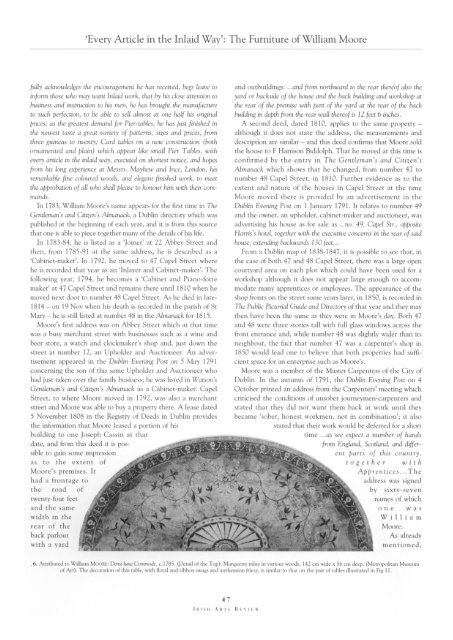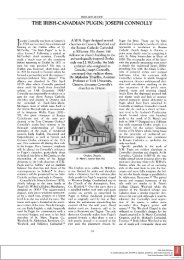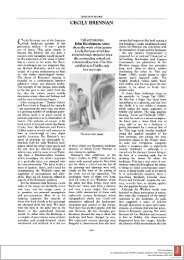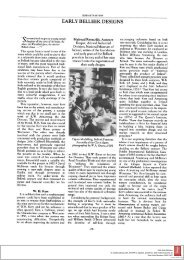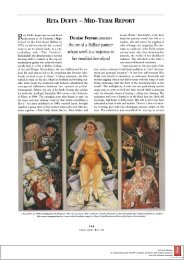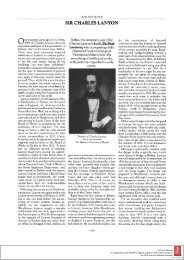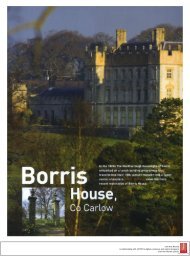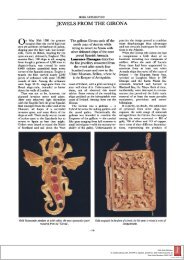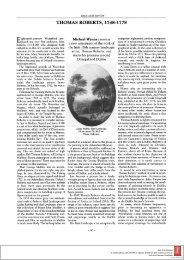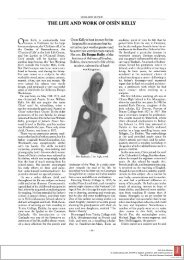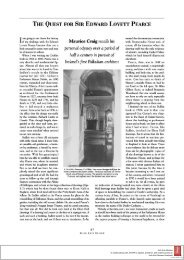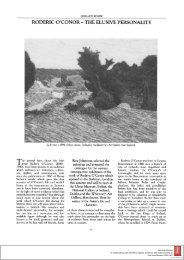1. William MOORE
1. William MOORE
1. William MOORE
Create successful ePaper yourself
Turn your PDF publications into a flip-book with our unique Google optimized e-Paper software.
'Every Article<br />
in the Inlaid Way': The Furniture of <strong>William</strong> Moore<br />
fully acknowledges the encouragement he has received, hegs leave to<br />
inform those who may want Inlaid work, that by his close attention to<br />
business and instruction to his men, he has brought the manufacture<br />
to such perfection, to be able to sell almost at one half his original<br />
prices; as the greatest demand for Pier-tables, he has just finished in<br />
the newest taste a great variety of patterns, sizes and prices, from<br />
three guineas<br />
to twenty; Card tables on a new construction (both<br />
ornamented and plain) which appear like small Pier Tables, with<br />
every article in the inlaid way, executed on shortest notice, and hopes<br />
from his long experience<br />
at Messrs.<br />
Mayhew and Ince, London, his<br />
remarkable fine coloured woods, and elegant finished work, to meet<br />
the approbation of all who shall please to honour him with their com<br />
mands.<br />
In 1783, <strong>William</strong> Moore's name appears for the first time in The<br />
Gentleman s and Citizen's Almanack, a Dublin directory which was<br />
published at the beginning of each year, and it is from this source<br />
that one is able to piece together many of the details of his life.<br />
In 1783-84, he is listed as a 'Joiner' at 22 Abbey Street and<br />
then, from 1785-91 at the same address, he is described as a<br />
'Cabinet-maker'. In 1792, he moved to 47 Capel Street where<br />
he is recorded that year as an<br />
'Inlayer and Cabinet-maker'. The<br />
following year, 1794, he becomes a 'Cabinet and Piano-forte<br />
maker' at 47 Capel Street and remains there until 1810 when he<br />
moved next door to number 48 Capel Street. As he died in late<br />
1814 - on 19 Nov when his death is recorded in the parish of St<br />
Mary - he is still listed at number 48 in the Almanack for 1815.<br />
Moore's first address was on Abbey Street which at that time<br />
was a busy merchant street with businesses such as a wine and<br />
beer store, a watch and clockmaker's shop and, just down the<br />
street at number 12, an Upholder and Auctioneer. An adver<br />
tisement appeared in the Dublin Evening Post on 5 May 1791<br />
concerning the son of this same<br />
Upholder and Auctioneer who<br />
had just taken over the family business; he was listed in Watsons<br />
Gentleman's and Citizens Almanack as a Cabinet-maker. Capel<br />
Street, to where Moore moved in 1792, was also a merchant<br />
street and Moore was able to buy<br />
a property there. A lease dated<br />
5 November 1808 in the Registry of Deeds in Dublin provides<br />
the information that Moore leased a portion of his<br />
building to one Joseph Cassin at that<br />
date, and from this deed it is pos<br />
sible to gain<br />
some<br />
impression<br />
as to the extent of<br />
Moore's premises. It *<br />
had a frontage to<br />
the road of<br />
twenty-four<br />
and the same<br />
width<br />
in the<br />
rear of the<br />
back parlour<br />
feet<br />
with a yard<br />
/ i<br />
and outbuildings: ...and from northward to the rear<br />
thereof also the<br />
yard or backside of the house and the back building and workshop at<br />
the rear of the premise with part of the yard at the rear of the back<br />
building in depth from the rear wall thereof is 12 feet 6 inches.<br />
A second deed, dated 1810, applies<br />
to the same property<br />
although it does not state the address, the measurements and<br />
are<br />
-<br />
description<br />
similar and this deed confirms that Moore sold<br />
the house to F Harrison Biddolph. That he moved at this time is<br />
confirmed by the entry in The Gentleman's and Citizen s<br />
Almanack which shows that he changed, from number 47 to<br />
number 48 Capel Street, in 1810. Further evidence as to the<br />
extent and nature of the houses in Capel Street at the time<br />
Moore moved there is provided by<br />
an advertisement in the<br />
Dublin Evening Post on 1 January 179<strong>1.</strong> It relates to number 49<br />
and the owner, an<br />
upholder, cabinet-maker and auctioneer, was<br />
advertising his house as for sale as ...no. 49, Capel Str., opposite<br />
Harris's hotel, together with the executive concerns in the rear<br />
-<br />
of said<br />
house, extending backwards 130 feet...<br />
From a Dublin map of 1838-1847, it is possible to see that, in<br />
the case of both 47 and 48 Capel Street, there was a large open<br />
courtyard<br />
area on each plot which could have been used for a<br />
workshop although it does not appear large enough<br />
modate many apprentices<br />
or<br />
to accom<br />
employees. The appearance of the<br />
shop fronts on the street some years later, in 1850, is recorded in<br />
The Public Pictorial Guide and Directory of that year and they may<br />
then have been the same as<br />
they<br />
were in Moore's day. Both 47<br />
and 48 were three stories tall with full glass windows across the<br />
front entrance and, while number 48 was<br />
slightly wider than its<br />
neighbour, the fact that number 47 was a<br />
carpenter's shop<br />
in<br />
1850 would lead one to believe that both properties had suffi<br />
cient space for an<br />
enterprise such as Moore's.<br />
Moore was a member of the Master Carpenters of the City of<br />
Dublin. In the autumn of 1791, the Dublin Evening Post on 4<br />
October<br />
printed<br />
an address from the Carpenters' meeting which<br />
criticised the conditions of unsober journeymen-carpenters and<br />
stated that they<br />
did not want them<br />
back at work until they<br />
became 'sober, honest workmen, not in combination'; it also<br />
stated that their work would be deferred for a short<br />
time<br />
...as we<br />
expect<br />
a number<br />
of hands<br />
from England, Scotland, and differ<br />
ent<br />
parts of this country,<br />
together<br />
Apprentices.<br />
address<br />
by<br />
names<br />
one<br />
was<br />
with<br />
sixty-seven<br />
<strong>William</strong><br />
Moore.<br />
As<br />
mentioned,<br />
..The<br />
signed<br />
of which<br />
was<br />
already<br />
,6. Attributed to <strong>William</strong> <strong>MOORE</strong>: Demi-lune Commode, c.1785. (Detail of the Top). Marquetry inlay in various woods, 142 cm wide x 56 cm deep. (Metropolitan Museum<br />
of Art). The decoration of this table, with floral and ribbon swags and anthemion frieze, is similar to that on the pair of tables illustrated in Fig 1<strong>1.</strong><br />
47<br />
Irish Arts Review


